While we explore our planet, so many different types of finches begin to emerge. Arguably one of the most beautiful and colorful birds on the planet earth, Finches belong to the family of Fringillidae. Despite their widespread distribution across the globe, these birds primarily reside in the Northern Hemisphere and are native to Neotropics and Hawaii Islands. These types of birds feed on small insects, aquatic plants, roots, seeds, weeds, worms and crustaceans. They are found in the lowlands, woodlands and coniferous forests.
Types of Finches
Pine Grosbeak
The Pine Grosbeak (Pinicola enucleator) is generally found in the coniferous forests all throughout Alaska, Canada, United States, New England, Siberia, Germany and North America.
Durbec des sapins is the French name of these birds.
These types of finches are the large members and they have greater bills and black wings.
The females exhibit yellow head coupled with grayish underparts.
These are not the migratory birds. However, in case of non-availability of food they might migrate toward south.
Grosbeak predominantly feed on small insects, seeds, berries and buds. More than 99% of their diet is composed of vegetables including spruce, seeds, maple, mountain ash, elm and pine.
The length of the pine grosbeak is about 20 – 25 cm (7.9 – 9.8 inches).
These types of finches have a wingspan of about 33 cm (13 inches).
Grosbeak weighs around 53 – 78 grams.
The clutch size comprises 2 – 5 pale blue spotting eggs.
Golden-winged grosbeak

- Golden-winged grosbeak is one of the small types of finches and it belongs to the family of Fringillinae. These attractive birds are the permanent residents of Somalian regions.
- They are mainly found in the scrub areas.
- These birds primarily feed on spurges, acacias, and junipers.
- There is no significant difference between the plumages of males and females.
Socotra Grosbeak
-

Socotra Grosbeak The Socotra Grosbeak Rhynchostruthus socotranus is a bird that is native to the Indian Ocean. The population of these kinds of finches has significantly decreased over the years.
- These species are also known as Golden-winged Grosbeak.
- The plumage of males is brownish and a black bill together with black mask gives a distinctive look to this beautiful bird.
- There are bright yellow markings all over the wings and tail.
- There is no significant difference between the outlook of females and males.
- These types of finches primarily build their habitats on woodlands, and mountains where spurges and juniper plants are extensively available.
- Socotra Grosbeak has a total population of about 6,500 individuals.
Arabian Grosbeak

- The Arabian Grosbeak (Rhynchostruthus percivali)is endemic to Saudi Arabia and Yemen.
- The plumage is similar to that of Socotra Grosbeak with a little difference of dark grey mask coupled with white cheeks.
- The chicks do not exhibit the same plumage patterns.
- These types of finches predominantly reside within a range of 1,060 – 2,800 m in scrub areas.
- Yemen, Oman, Dhofar, Mahrah and Saudi Arabia are the most common places where these birds are found.
- They rely on plants and roots for their basic diet.
- There are almost 9,000 individuals existing today globally. However, due to deforestation and habitat destruction the sudden decline in population has been observed in recent times.
Somali Grosbeak

- As the name indicates, Somali Grosbeak (Rhynchostruthus louisae) is a native to Somalia. Like other types of finches, population of Somali Grosbeak is also known to decrease considerably.
- The golden winged grosbeaks are slightly greater than the Somali grosbeaks, but the plumages are almost the same.
- It’s very hard to distinguish between the male and female Somali grosbeak.
- They are mainly found in the East African Juniper (plant) the fruit of which comprises most of its diet.
- Biologists are still uncertain about the exact population of these types finches.
Bonin Grosbeak
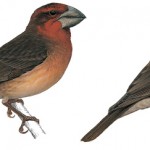
- The Bonin Grosbeak (Chaunoproctus ferreorostris) is one of the extinct finches. These birds are also known as Bonin Islands Grosbeak.
- These finches predominantly rely on fruits and buds for their daily feed.
- These types of finches are often reluctant to fly.
- They have a low-pitched sound and are usually produced in a series.
- These kinds of finches also roost in trees.
- Chichi-jima and Ogasawara islands are the two main islands where these birds usually reside.
- This specie was discovered back in 1827 for the first time in a wildlife history.
Kona Grosbeak

- The Kona Grosbeak (Chloridops kona) belongs to the subfamily of Drepanidinae and is mainly found in the Myoporum forests. These types of finches reside at an elevation of about 1,400 – 1,500 m (4,600 – 4,900 feet) in Hawaii Island.
- The population is considerably reducing during the recent times but the cause is still unknown.
- The length of the Kona Grosbeak measures around 15 cm (5.9 inches).
- These medium sized birds exhibit greenish plumage coupled with a brownish beak.
- These finches typically feed on fruits, small invertebrates and aquatic plants.
Yellow Grosbeak
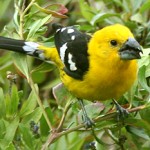
- The Yellow Grosbeak (Pheucticus chrysopeplus) mainly subsides in the Pacific slope of Mexico. These medium sized birds primarily eat seeds and are also known as Mexican Yellow Grosbeak.
- They build their habitats in woodland and forests of California, New Mexico, Colorado Arizona and Iowa. They rarely travel towards United States.
- These types of finches are 21.5 – 24 cm (8.5 – 9.5 inches) long.
- The weight of yellow grosbeak is around 62 grams (2.2 oz).
- True to its name, yellow grosbeak reflects yellow plumage along with its grayish undersides.
- The females lay 2 – 5 bluish eggs.
- The nests are built on trees at a reasonable height.
Black-thighed Grosbeak

- The Black-thighed Grosbeak Pheucticus tibialis is native to the Costa Rica western Panama Mountains.
- They are known to breed at a height of about 1,000 metres to 1,500 metres. Black-thighed grosbeak is normally found in the woodlands or forests that may or may not be wide open.
- The breeding season lasts from March to May.
- The females lay 1 – 3 brown-spotted eggs.
- The length of these birds is around 20 cm.
- These types of finches weigh around 70 grams.
- These species primarily feed on fruits, berries, and small insects.
Rose-breasted Grosbeak
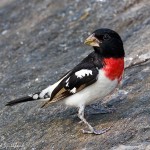
- The Rose-breasted Grosbeak Pheucticus ludovicianus is relatively a large seed-eating bird and is inhabitant of North America.
- These types of finches are the migratory birds in that they travel toward tropical regions during winter season.
- Rose-breasted grosbeak is 18 – 22 cm (7.1 – 8.7 inches) long.
- The wingspan of these birds is about 29 – 33 cm (11 – 13 inches).
- The weight is around 35 – 65 grams (1.2 – 2.3 oz). However, the average weight is 46 grams (1.6 oz).
- They are commonly found in the woodlands and forests of Canada, United States, Mexico, Caribbean, Peru, Venezuela, Columbia, and Costa Rica.
- They usually migrate during the months of September and October.
- These kinds of finches predominantly feed on small insects, seeds, roots, nectar, and berries.
- They generally reside at the treetops and are not often seen on land.
Black-headed Grosbeak

- The Black-headed Grosbeak Pheucticus melanocephalus belongs to the family of Cardinalidae and is medium sized bird. Black-headed grosbeak is one of those types of finches that migrate from the British Columbia toward western United States.
- The length of these finches is about 18 – 19 cm (6 – 7 inches).
- They have black head and black wings in which white markings are embedded.
- They build their habitats at lakeshores, river bottoms, conifer forests and wetlands.
- The nests are typically at a height of about 3 – 35 feet above the ground.
- The females lay 2 – 5 reddish brown eggs.
- The incubation (keeping warm) period lasts for 11 – 12 days.
- These species primarily feed on seeds, insects, fruits, berries, spiders, and pine.
Black-faced Grosbeak

- The Black-faced Grosbeak (Caryothraustes poliogaster) is a large bird that is endemic to Mexico and Panama.
- These types of finches are 16.5 cm long.
- The weight of black-faced grosbeak is around 36 grams.
- They have a black face and the head is yellow in color together with olive wings.
- These birds largely eat caterpillars, insects, beetles, seeds, nectar, and honeycreepers.
- They are generally found in the tropical and subtropical forests.
- These species breed in Caribbean lowlands at an elevation of 1,000 metres.
- They build nests at a height of about 3 – 6 metres.
- The females lay 2 – 3 grayish eggs.
Crimson-collared Grosbeak

- The Crimson-collared Grosbeak (Rhodothraupis celaeno) breeds all throughout Northeastern Mexico, Veracruz, Southern Texas, and Central Tamaulipas.
- The adult males exhibit black plumage coupled with reddish collar. Females have black breast and yellowish underparts.
- They have a whistling kind of sound.
- These birds normally reside in the semi-arid forests and may not necessarily be restricted to the high or low levels.
- These types of finches lay 2 – 3 brown spotting eggs.
Evening Grosbeak

- The Evening Grosbeak (Coccothraustes vespertinus) is a member genus of Hesperiphona vespertina and is arguably large bird.
- Evening grosbeaks primarily subside in the tropical and subtropical forests across Canada, United States, and Mexico.
- These birds are strong migratory birds.
- The length of these beautiful finches is around 18.5 cm (7.3 inches).
- They have a very short tail along and a yellow forehead.
- These species predominantly feed on small insects, weeds, seeds, and berries.
- They are also known to travel in large flocks.
Hawfinch

- The Hawfinch (Coccothraustes coccothraustes) is close relative of Evening Grosbeak and is endemic to North America, Central America and Mexico.
- They are known to breed all throughout Europe and Asia.
- These types of finches mainly build their habitats in large trees and woodlands.
- The females lay 2 – 7 eggs.
- They primarily eat fruit kernels and seeds of cherries.
- Hawfinches are 16.5 – 18 cm long.
House Finch

- The House Finch (Carpodacus mexicanus) is a member genus of Carpodacus. As compared to hawfinches, these birds do have a long tail and grayish color feathers.
- These are partial migratory birds and they generally breed across Florida, Canada, Mexican State, and Central Chipas.
- House finches largely feed on grains, vegetation, small insects, sunflowers, seeds, and berries.
- They build their nests in tree cavities or any left-over space in buildings.
- Females are normally responsible for building nests and it takes almost 2 days to complete. These nests are at a height of 1.8 – 2.7 metres (5.9 – 8.9 feet) above the ground.
- The breeding season ranges from February to August.
- The females lay 2 – 6 pale blue eggs.
- The females incubate (keeping warm) eggs and the incubation period lasts for 12 – 14 days.
- The chicks begin to flap their wings after 12 – 20 days.
- These types of finches are believed to be aggressive toward other species.
- Several parasites led to the reduction of house finch’s population in America.
Purple Finch

- The Purple Finch (Carpodacus purpureus) belongs to the family of Fringillidae and is a member genus of Carpodacus.
- The purple finch is about 15 cm (4 inches) long.
- These types of finches weigh around 34 grams (1.2 oz).
- These species breed all throughout woodlands of Canada, and U.S Pacific Coast.
- They are considered to be the permanent residents.
- Like other finches, they also feed on seeds, berries and insects.
Species
- C. p. purpureus
- C. p. californicus
Gray-crowned Rosy Finch

- The Gray-crowned Rosy Finch (Leucosticte tephrocotis) belongs to the family of Fringillidae and is endemic to Alaska, Canada and United States.
- Gray-crowned bird is a medium sized bird with a long tail.
- The length of these types of finches is about 140 – 160 mm (5.5 – 6.3 inches). Some species are even 170 – 210 mm (6.7 – 8.3 inches) long, with the weight of 42 – 60 grams (1.5 – 2.1 oz).
- The wingspan is about 33 mm (1.3 inches).
- These species weigh around 22 – 26 grams (0.78 – 0.92 oz).
- They are known to breed in the rocky or barren mountainous areas of Alaska or United States.
- Females normally lay 3 – 5 eggs and the incubation period lasts for 12 – 14 days. Only females incubate eggs.
- The juveniles fledge out after 18 – 22 days.
- These types of finches mainly eat cutworms, flying insects, bugs, weeds and seeds. They live near vegetation so that these foodstuffs should be easily available.
Species
- L. t. griseonucha
- L. t. umbrina
- L. t. littoralis
- L. t. tephrocotis
- L. t. wallowa
- L. t. dawsoni
Desert Finch
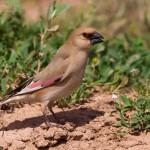
- The Desert Finch (Carduelis obsoleta) is a large bird that mainly breeds in the Southern Eurasia. Lichtenstein’s Desert Finch is the other name of these types of finches.
- Desert finch has a wingspan of about 26 cm (10 inches).
- They are generally found in the low mountains and foothills.
- They primarily eat insects or fruits.
- Females lay 4 – 6 eggs.
European Greenfinch
- The European Greenfinch is a bird that breeds all throughout Asia, Europe, Australia, New Zealand and Africa. These birds are also known as Green Finches.
- They build their habitats on farmlands or gardens that are dominated by thick vegetation.
- Females lay 3 – 8 eggs.
- These birds primarily eat seeds and berries.
- European Finch is 15 cm long.
- The wingspan is about 24.5 – 27.5 cm.
Eurasian Siskin

- The Eurasian Siskin (Carduelis spinus) breeds across Asia and Europe. These types of finches build their habitats in the mixed woodlands or coniferous forests.
- While males exhibit yellow face and breast, females display grayish head without a cap.
- They like to interact with other species as they are highly sociable. Eurasian Siskin can be easily kept under captivity.
- These birds are 11 – 12.5 cm (4.3 – 4.9 inches).
- The wingspan is about 20 – 23 cm (7.9 – 9.1 inches).
- The weight of Eurasian siskin is around 10 – 18 g (0.35 – 0.63 oz).
- They are found in Central Europe, Scandinavia, Russia, Tibet, Mediterranean Basin, Inner Mongolia, Khingan Mountains and Yangtse River.
- Females lay 2 – 6 light grey eggs.
- The total population of these finches is about 20 – 26 million globally.
- Eurasian Siskin feed on elms, insects, conifer seeds, beetles, and poplars.
- The incubation period lasts for 10 – 14 days.
- The average lifespan is about 11 – 14 years.
Pine Siskin

- The Pine Siskin (Carduelis pinus) is a migratory bird which is endemic to North America.
- There are few yellow markings over its wings.
- The length of these finches is about 11 – 14 cm (4.3 – 5.5 inches).
- They have a wingspan of about 18 – 22 cm (7.1 – 8.7 inches).
- These species weigh around 12 – 18 grams (0.4 – 0.6 oz).
- They breed all throughout Canada, Alaska and United States.
- Pine siskin primarily feed on insects, plant roots, and seeds.
- They mainly hunt in shrubs and weeds.
Yellow-bellied Siskin

- The Yellow-bellied Siskin Carduelis xanthogastra is a small bird and it breeds across Costa Rica, Bolivia, and Ecuador. Some species also exist in the northwestern Venezuela.
- These types of finches generally breed at an elevation of about 800 – 3000 m.
- The breeding period ranges from April to May.
- They build nests at a height of 2.4 – 3.7 metres.
- Yellow belied are not considered to be the migratory birds.
- These kinds of finches are 10.5 cm long.
- These species weigh around 12 grams.
Species
- C. x. stejnegeri
- C. x. xanthogastra
Twite

- The Twite (Carduelis flavirostris) also belongs to the family of Fringillidae and is a small bird.
- The length of the Twite is around 13 – 13.5 cm (5.1 – 5.3 inches).
- It has reddish brown underparts. No significant difference is observed between males and females however, juveniles do not look similar to their parents.
- They are known to breed all throughout Europe and Asia. the population has been observed to decline in Ireland.
- Females lay 4 – 7 eggs.
Lesser Redpoll

- The Lesser Redpoll (Carduelis cabaret) belongs to the family of Fringillidae. These types of finches are endemic to Europe and have also been introduced in New Zealand recently.
- Most of these species are migratory; in winter they travel toward south.
- The length of the lesser redpoll is about 11.5 – 12.5 cm (4.5 – 4.9 inches).
- They have a wingspan of about 20 – 22.5 cm (7.9 – 8.9 inches).
- These species weigh around 9 – 12 g (0.32 – 0.42 oz).
- Most of these species reside in Great Britain and Ireland. Apart from these places they are also found in France, Germany, Norway, Denmark, Sweden and Poland.
- They are known to breed in woodlands, dunes, shrubs, and farmlands. These types of finches normally prefer wide areas where they can easily see their predators.
- They are highly sociable birds and they mainly eat seeds, grasses, birch, fruit buds, and invertebrates.
- The nests are built from wigs, stems, leaves, grass and roots.
- Females lay 2 – 7 pale blue eggs.
- The incubation (keeping warm) lasts for 12 – 15 days and females contribute towards incubation.
- The chicks fledge out after 9 – 12 days.
Two-barred Crossbill

- The Two-barred Crossbill (Loxia leucoptera) is a small finch and it breeds across Alaska, Canada, United States, Asia and Europe.
- Females lay 3 – 5 eggs.
- Males exhibit pinkish color while females show greenish yellow plumage.
Species
- Loxia leucoptera leucoptera
- Loxia leucoptera bifasciata
Lesser Goldfinch

- The Lesser Goldfinch (Carduelis psaltria) is a small North American Bird and is also known as Dark-backed Goldfinch.
- The length of these birds is about 10 – 11 cm (4 – 4.5 inches).
- Lesser goldfinch weighs around 9.5 grams (0.3 oz).
- These types of finches are widely distributed across the Rocky Mountains, Sierra Madre Occidental, Southern Sonora, Pacific Coast, New Mexico, Colorado, Texas, United States, Nayarit, Sinaloa, and Isthmus of Tehuantepec.
- These species are known to exist in large flocks. They usually build their habitats in dense forests and shrubs.
- They primarily feed on weeds or seeds.
- The breeding season ranges from September to October. Females lay 3 – 4 bluish eggs.
Lawrence’s Goldfinch

- Lawrence’s Goldfinch (Carduelis lawrencei) is a small bird that breeds across California, Baja California and Mexico.
- The length of these finches is about 12 cm (4.75 inches).
- Lawrence’s goldfinch weigh around 11.5 grams (0.4 oz).These types of finches have a yellow plumage.
- They are normally found in Coast Ranges of Sierra Nevada, California, Mount Pinos, Carmel Valley, and South Fork Kern River.
- These birds predominantly feed on shrubs, seeds, insects, and forbs.
- The breeding season begins at the end of July.
- These types of finches build their nests at a height of about 10 feet (3 metres).
- Females lay 3 – 6 pure white eggs.
- The incubation period lasts for 12 – 13 days.
- The juveniles fledge out after 12 – 14 days.
- In a single flock, there exist about 50 individuals on an average.
Gouldian Finch
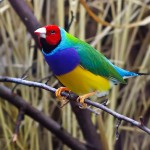
- The Gouldian Finch, Erythrura gouldiae is an inhabitant of Australia and is also known as Rainbow Finch. Gouldian finch is one of the most beautiful and colorful finches among all the species.
- Both males and females exhibit dark green, yellow, red and black plumage.
- The length of gouldian finch is about 130 – 140 mm.
- These birds are known to breed in Western Australia and Queensland.
- These finches are found in large flocks of about 1,000 – 2,000 individuals.
- The usually eat seeds and crops.
- Females lay 4 – 8 eggs.
- The chicks leave their nests after 19 – 23 days.
Zebra Finch

- The Zebra Finch, Taeniopygia guttata is a bird that is endemic to Australia and is a member genus of Taeniopygia.
- They are also known to breed in Indonesia, Brazil, United States, Portugal, and East Timor.
- These species are 10 cm (3.9 inches) long.
- Most of their diet comprises seeds and weeds.
- They build their habitats in tree cavities, bushes, low trees, and scrubs.
- The lifespan of zebra finch is about 5 years in the wild; however, under captivity they can live up to 8 – 10 years. One of the highest lived zebra finch was recorded at 14.5 years under captivity.
Species
- Taeniopygia guttata guttata
- Taeniopygia guttata castanotis
Diamond Firetail

- The Diamond Firetail Stagonopleura guttata is a native bird of Australia and it belongs to the family of Estrildidae. It is a member genus of Stagonopleura.
- These red-eyed birds are found to breed in Eyre Peninsula, Queensland and Great Dividing Range.
- They build their habitats in woodlands, farmlands or forests.
- Both parents contribute toward constructing the nest but the finishing touch is given by the female only. Generally, the material used for building nests is shredded paper, dried grass, coconut fibers, and feathers.
- The breeding period ranges from April to August.
- Females usually lay 4 – 6 eggs.
- The incubation (keeping warm) period lasts for 14 days.
- The hatching period lasts for 3 weeks.
- The juveniles fledge out after 21 days.
- The average lifespan of these types of finches is about 5 – 7 years.
- These birds predominantly feed on small insects, larvae, fruits like berries, and seeds.
Red-browed Finch
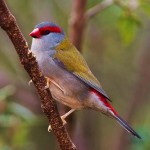
- The Red-browed Finch (Neochmia temporalis) is a bird that is endemic to Australia. These types of finches are normally found in the dry savanna habitats. It is a member genus of Neochmia.
- The length of red browed finch is around 11 – 12 cm.
- These birds like to socially interact which is why they can be easily kept under captivity.
- These species are also found in the gatherings comprising 10 – 20 individuals.
- They build their nests at a height of about 2 – 3 m above the ground.
- The clutch size consists of 4 – 6 eggs.
- Females lay 4 – 6 eggs.
- The breeding period ranges from October to April.
- The chicks begin to fledge out after 28 days.
Species
- N. temporalis temporalis
- N. temporalis minor
- N. temporalis loftyi
Double-barred Finch

- The Double-barred Finch Taeniopygia bichenovii is a small finch that belongs to the family of Estrildidae and is also a member genus of Taeniopygia.
- They are commonly known to breed in the dry grasslands in the eastern Australia.
- These types of finches are also known as Owl finch or Bicheno’s Finch.
- These species are 10 – 11 cm long and they exhibit brownish shade underside feathers.
- There is a black line that runs across its neck.
Species
- Taeniopygia bichenovii bichenovii
- Taeniopygia bichenovii annulosa

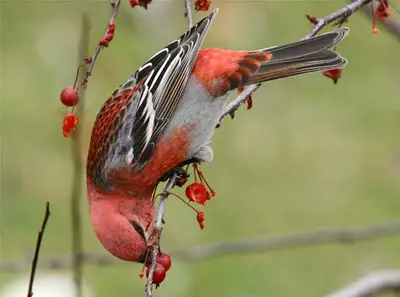
Leave a Reply